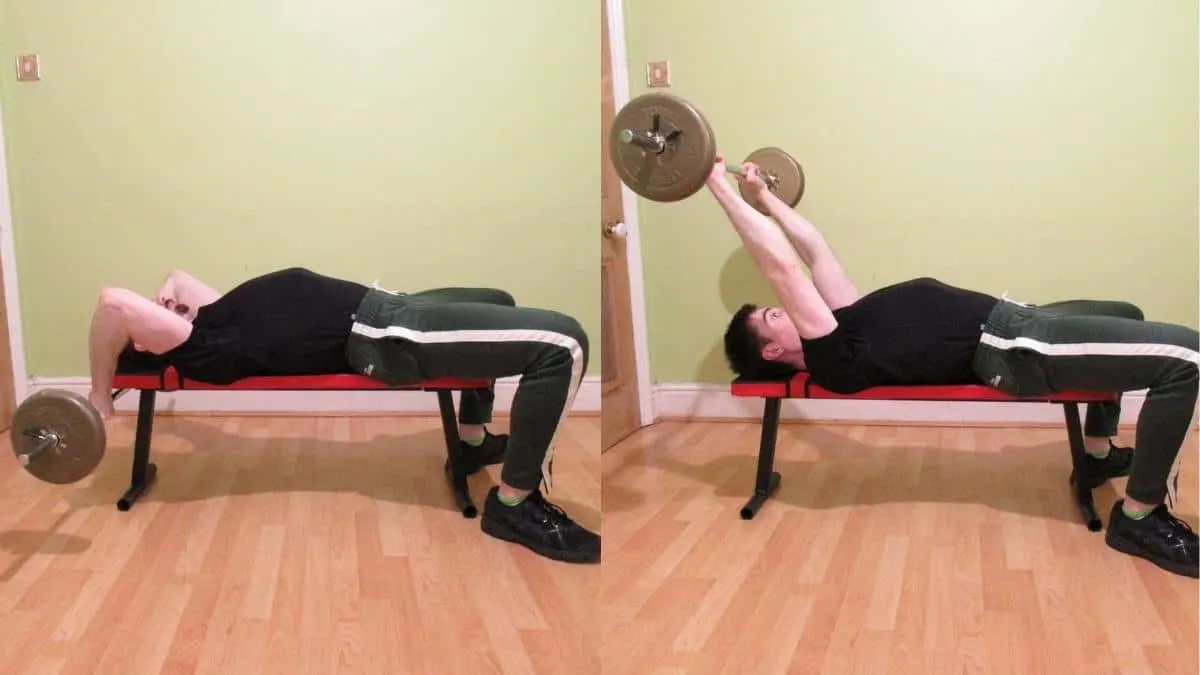Performing a barbell lying tricep extension is an effective method for building bigger arms because the exercise enables you to overload your triceps with plenty of resistance.
The movement also has excellent carryover to your compound presses because it gets you used to locking out heavy free weights with your triceps. So if you want to boost your bench press strength and improve your lockout power, it’s a smart idea to include the lying barbell extension in your workout routine.
This guide explains how to do a lying barbell tricep extension with the perfect form and then, after discussing the pros and cons of the exercise, shows you three extra barbell tricep extension variations that you can do to train your triceps from different angles.
Related: Barbell exercises for triceps
Barbell lying tricep extension exercise details
- Also Known As: BB lying tricep extension, straight bar lying tricep extension
- Main Muscles: Triceps
- Exercise Type: Strength
- Exercise Mechanics: Isolation
- Difficulty Level: Intermediate
- Equipment Needed: Barbell, weights, bench
How to do a lying barbell tricep extension
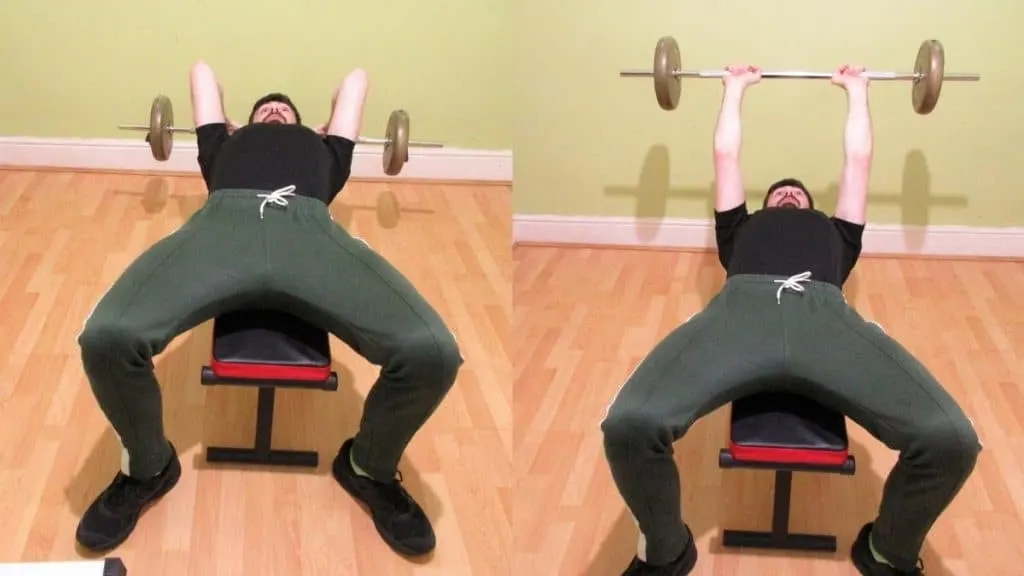
- Grab a straight bar with a pronated grip just inside shoulder width.
- Lie on a flat bench with the bar in your hands, and then press the bar up so that it’s positioned over your head.
- Lower the bar behind your head—indeed, behind the bench—until you feel an intense stretch in the long (inner) head of your triceps.
- Reverse the motion by flexing your triceps until your elbows are completely locked out.
- Perform 3-5 sets of 8-20 reps in total.
Lying barbell tricep extension pros and cons
Barbell lying tricep extensions are a staple mass-builder in the routines of many bodybuilders because the movement enables you to overload your triceps with more resistance than any other isolation exercise.
Yet, there are also a couple of drawbacks that make the exercise somewhat imperfect for long-term strength progression.
Pro: Ideal for building mass

All else being equal—form, mind-muscle connection, diet quality, recovery—lifting heavier weights will lead to greater hypertrophy.
In this regard, performing the lying tricep extension barbell style is ideal for building mass. This is because straight bars are highly conducive to lifting heavy weights and overloading your muscles with resistance since they require less stabilization than dumbbells.
Yet, lying barbell triceps extensions are also an excellent mass-builder by their very nature. Even though the lying barbell triceps extension hits all three tricep heads, the exercise gives particular emphasis to the long head, which is the largest head of the triceps.
This is because the long head has a dual function: shoulder extension and elbow extension.
So when you bring the barbell behind your head during the lying barbell extension or the seated barbell extension, you’re naturally integrating these functions into the same exercise and thus giving the long head the best possible hypertrophy stimulus.
Pro: Great for gaining strength

If you want to gain triceps strength quickly, then lying barbell tricep extensions are one of the best exercises for the job because they’re highly conducive to progressive overload.
How so?
Because you can smash through strength plateaus by adding fractional plates to the barbell—a technique that’s especially effective when you’re training a relatively small muscle like the triceps.
Sure, increasing the resistance by half a pound might not seem like a lot of extra weight. But these little weight increases really start to stack up over the weeks and months, and besides, microloading sure beats lifting the same weight every session.
This extra triceps strength will carry over nicely to your compound presses because the sticking point during a barbell lying tricep extension is the same as the sticking point in a bench press and overhead press (triceps wise) which is to say as you lockout the bar.
Con: Forces your wrists into pronation
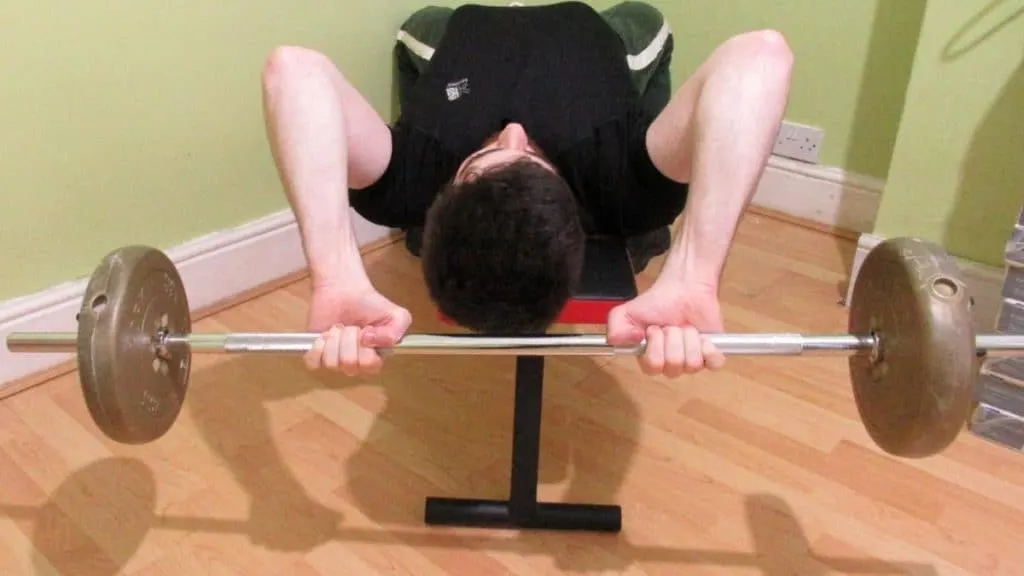
As effective as barbell lying tricep extensions are for building triceps size, they’re not exactly what you’d call a wrist-friendly exercise.
Using a straight bar for tricep extensions forces your hands into full pronation.
Now, if you’re a beginner, then this awkward wrist position is unlikely to cause you any discomfort because you simply won’t be lifting enough weight to where your wrists will feel the strain.
However, as you become stronger, the excessive pronation combined with the increasing resistance can really start to take its toll on your wrists.
For this reason, using an EZ bar rather than a straight bar is a good preventative measure against joint pain because easy curl bars have semi-pronated grips that are more comfortable to hold.
Lying barbell extension variations
Here are three additional lying barbell extension variations that you can do to work your triceps from a different angle.
Incline lying barbell triceps extensions
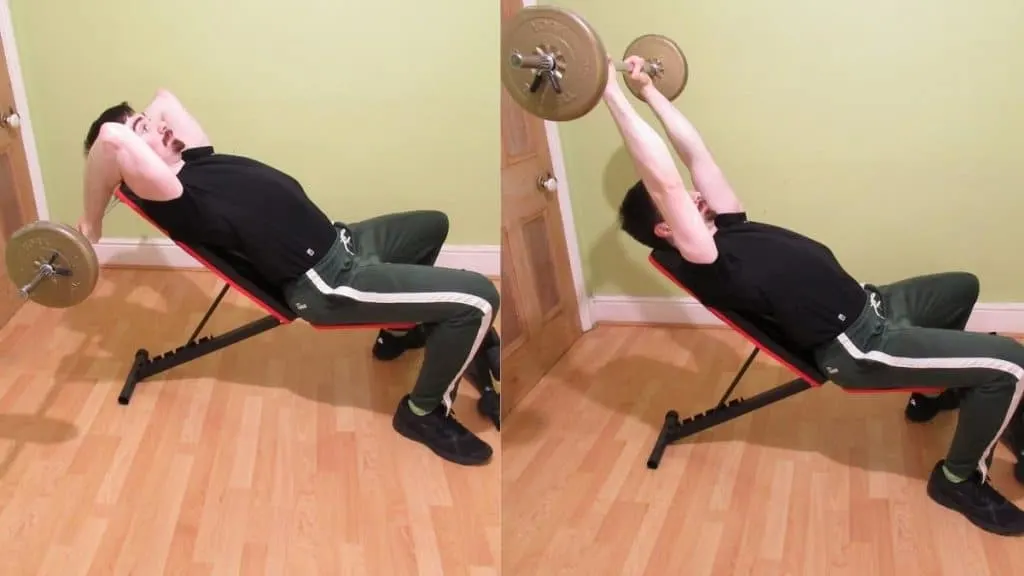
The incline barbell tricep extension is a cross between overhead extensions and flat barbell lying tricep extensions.
So you could say that you’re getting the best of both exercises (though they are very similar, to begin with).
Incline barbell extensions provide an excellent triceps stretch because you’re practically forced to lower the barbell well behind your head (otherwise, it could hit the bench). This weighted stretch translates into a potent muscle growth stimulus because the eccentric portion of the rep is crucial for hypertrophy.
The downside is that you could get stuck with the barbell behind the bench if you train to failure.
You could, of course, just drop the weight if you hit muscular failure. However, dropping a loaded barbell from such a height could be very dangerous for the people training close by. So your best bet is to recruit a spotter before you begin your set if you plan on training to failure.
Decline lying barbell triceps extension
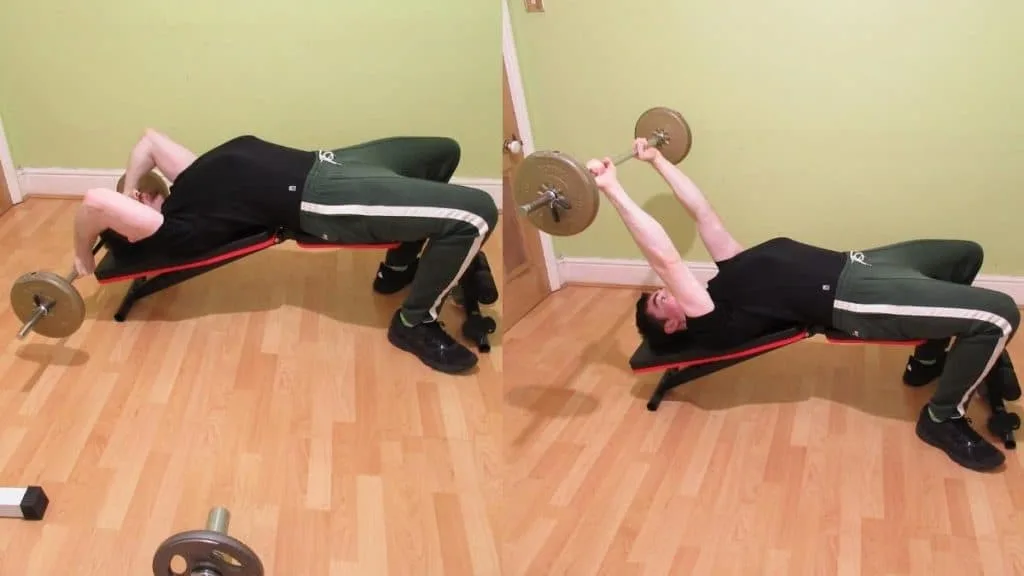
Due to the slope of the bench, the decline barbell triceps extension really encourages you to lower the bar well behind your head to take advantage of the BB lying tricep extension’s excellent eccentric stretch.
But since the lying barbell tricep extension is so conducive to heavy lifting, you’ll need a decline bench that has foot holders so that you don’t slide down the bench during the exercise.
A rock-solid core can definitely compensate for the lack of a foot holder, but when you’re training for hypertrophy, you want your body to be as stable as possible so that you can focus purely on working the target muscles.
Floor lying barbell tricep extensions
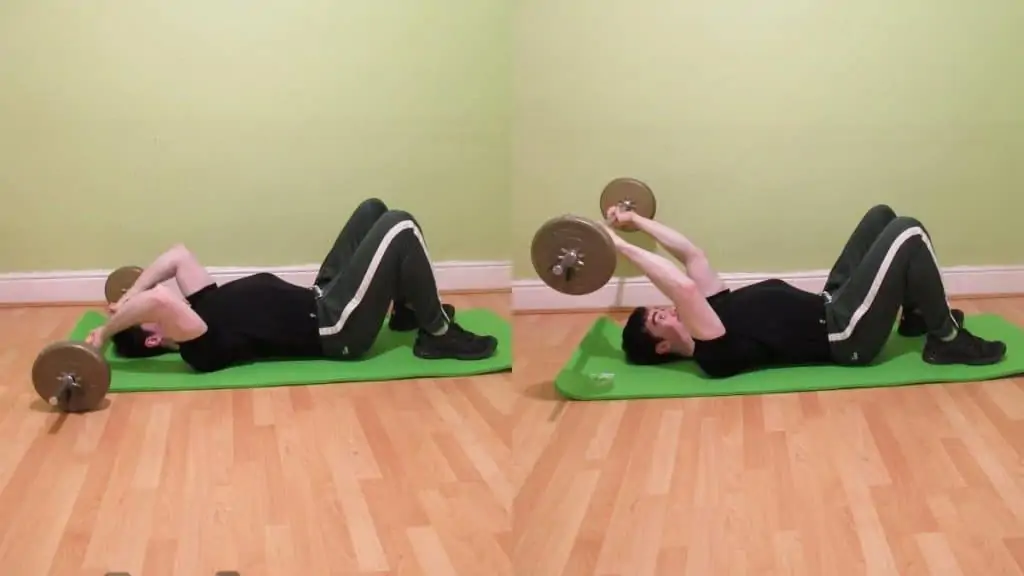
If you’re training at home or just don’t have access to a weight bench for whatever reason, then you can do a barbell tricep extension on the floor.
This variation is helpful for learning the proper form because you can touch the bar to the ground on every rep to ensure that you’re using a consistent range of motion. As such, when you add weight to the bar, you can be sure that it’s a result of your triceps strength and not because you’re reducing the range of motion in order to lift heavier weights (because you know that you’re always using the same range of motion when you touch the bar to the floor).
The drawback of doing lying barbell triceps extensions on the floor is that your range of motion is shorter by default. Specifically, the weight plates might hit the floor before your triceps receive an optimal stretch.
So be sure to use small weight plates or, to be on the safe side hypertrophy-wise, stick to the bench version where you can lower the bar under your head to really intensify the eccentric stretch.
Conclusion: How effective is the barbell lying tricep extension?
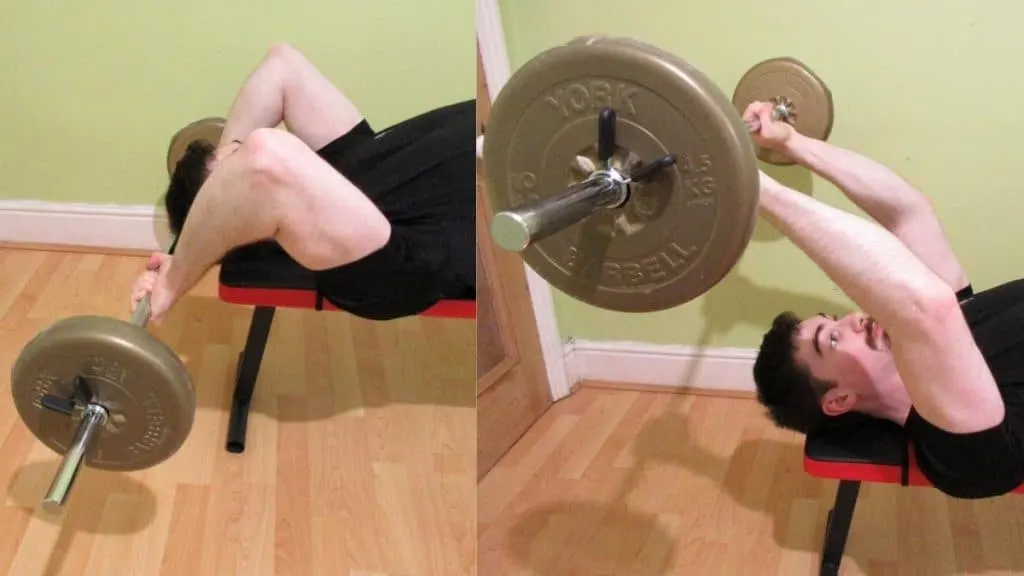
The barbell lying tricep extension has excellent mass-building potential because you can increase the resistance regularly with the help of small weight discs and fractional plates.
Furthermore, since barbells require less stabilization than dumbbells, you can give your triceps maximum attention by making the straight bar your tricep training tool of choice.
The main lying barbell tricep extension drawback is that the exercise forces your wrists into full pronation.
So your best bet is to stick to moderate or high reps in order to limit the amount of torque going through your joints. That’s why we recommended sets of 8-20 reps for the lying barbell triceps extension even though the triceps, as the human body’s most fast-twitch muscle group, respond excellently to low reps.

